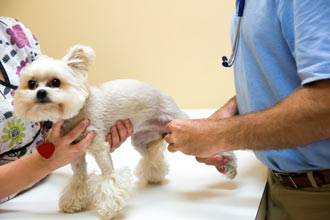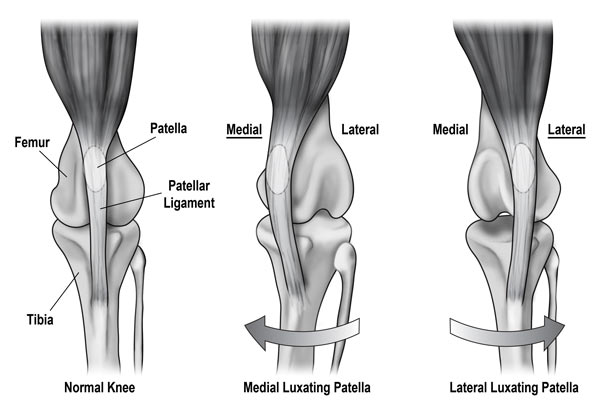Luxating Patella in Dogs

Luxating patella is one of the most common orthopedic problem in dogs. It is also called a "floating knee" or a "trick knee."
The canine leg, like the human one, consists of the femur (the thigh bone), the tibia and fibula (the shin bones), and the connecting knee joint. The patella is part of the knee joint and is more commonly known as the kneecap. It is a small, roundish bone within the tendon of the extensor muscle (the quadriceps) that runs between the femur and tibia bones. The patella rides in a groove at the bottom of the femur and moves in an up and down fashion during walking.
When a dog is affected by luxating patella, the kneecap does not always stay within its groove. Instead, it pops out while the dog is walking, causing the dog to carry the leg up until the patella pops back in.
About 20-25% of the time, luxating patella affects both legs in dogs (Brinker, 1990).
Luxating patella strains the knee joint and can lead to secondary conditions such as a ruptured anterior cruciate ligament.
Breeds, Gender, and Ages Most Commonly Affected by Luxating Patella
Toy breeds such as Yorkshire Terriers, Chihuahuas, miniature Poodles, and Pomeranians are most commonly afflicted with luxating patella. These small dogs usually develop a medial luxating patella. This means that the kneecap moves outside of its groove toward the inside of the knee joint.
Some giant breed dogs such as Akitas and Great Pyrenees also seem to be prone to luxating patella, though it is more common for them to have a lateral luxation, meaning that the kneecap leaves its groove toward the outside of the knee joint.
There is no gender predilection to luxating patella, but it is most commonly diagnosed in puppies around 4 months of age.
Signs and Presentation of Luxating Patella in Dogs
When the patella is outside of its groove, the dog is unable to fully extend his leg. An observer may note one or several steps in which the dog holds up his leg, then puts it down again and continues on normally. It may look as though the dog is skipping. In more severe cases, the dog will have an abnormal stance all the time. A crouched position in the rear end is adopted, with the dog throwing most of her weight onto the front legs. The rear feet may turn inward.
Causes of Luxating Patella in Dogs
When a young dog is diagnosed with luxating patella, it is most often the result of the following genetic characteristics:
- A patellar groove that is too shallow
- A stretched patellar ligament
- A patellar ligament attachment to the tibia that is too medial
- A combination of these abnormalities
While luxating patella is usually genetic it may also be related to trauma to the knee or another condition that aggravates the knee. This is usually another joint problem, such as hip dysplasia, that results in an abnormal gait which puts pressure on the patellar ligament. Luxating patella is sometimes caused by obesity, as the extra weight on the patellar ligament causes it to stretch and not hold the patella in place anymore.

Diagnosis of Luxating Patella in Dogs
Your veterinarian will examine your dog's knee in a specific way to determine whether the patella luxates abnormally out of its groove. Sometimes this examination needs to be done with the dog under sedation to properly evaluate the degree if disease present and any other concurrent conditions.
X-rays can also show the luxating patella and the degree of deviation in the tibia bone.

Luxating patella may be minor or quite extreme, and veterinarians use the following grading system to classify the severity of the disease in each affected dog.
- Grade 1: During an examination, a veterinarian can manually luxate the patella. When released, the patella returns to its groove easily and the dog shows very minimal or no limping behavior.
- Grade 2: The luxation of the patella is very frequent, the dog holds its leg up often but not always. The patella can manually be placed back into the groove during examination by a veterinarian but it re-luxates easily.
- Grade 3: The patella is permanently luxated and does not stay in its groove at all. The tibia bone is twisted toward the inside of the body (medially). Dogs with Grade 3 disease hold the affected leg up most of the time, though some will bear weight but keep the leg in an abnormal, partially-flexed position.
- Grade 4: The patella is permanently luxated and the tibia bone is twisted toward the inside of the body (medially) even more than in a Grade 3. The dog holds the leg up all of the time or walks in a very abnormal, crouched manner.
Treatment of Luxating Patella in Dogs
Surgery is the only way to fix luxating patella. Dogs with Grade 1 disease generally do not require surgical treatment, as signs are absent or mild, but dogs with Grades 2-4 disease usually do require surgical treatment. There are many types of surgery that may be helpful, including deepening of the patellar groove, attaching the patella to the outside of the femur bone, and realigning the tibia with the femur. Your veterinarian may refer you to a board-certified veterinary orthopedic surgeon to determine which surgical procedure(s) are most appropriate for your dog.
Prior to and after surgery, your veterinarian may recommend medications for your dog to help control pain and increase joint health. These medications may include the following:
- Non-steroidal anti-inflammatory medications like Deramaxx and Rimadyl can decrease inflammation and pain within the knee joint.
- Injectable glycosaminoglycans like Adequan can help repair cartilage and lubricate the knee joint.
-
Glucosamine-chondroitin supplements can help slow the progression of arthritis in joints.
Glucosamine supplements should be in the form of glucosamine hydrochloride (HCl) not glucosamine sulfate as glucosamine HCl has better bioavailability.
-
Omega 3 fatty acid supplements can have anti-inflammatory effects in the joints.
Omega 3 fatty acids should be in the form of fish or krill oils, not flaxseed. Fish and krill oils provide the correct forms of anti-inflammatory omega 3s, whereas flaxseed requires conversion to the anti-inflammatory compounds and dogs have limited amounts of the enzyme required to make this conversion
- Pain medications like Tramadol can be useful to simply block your dog's pain, especially immediately after surgery.
Some over-the-counter human medications are toxic to dogs. Never give your dog ANY medication without speaking with your veterinarian first.
Prevention of Luxating Patella in Dogs
Most cases of luxating patella in dogs have a genetic basis so the best way to decrease its overall presence in the dog population is to not breed dogs that have it.
Keeping your dog at a healthy weight throughout his life will decrease the chance that he will develop obesity-related luxating patella. Make sure that your dog is getting enough exercise and that you are feeding a diet that is appropriate for his life stage (adult dogs no longer need puppy food and senior dogs need a diet formulated for their special needs).
Prognosis for Luxating Patella in Dogs
The prognosis for dogs with luxating patella that receive proper surgical treatment and aftercare is excellent. The success rate for eliminating lameness is over 90% in these animals (Brinker, 1990).
Alternative Therapies for Luxating Patella in Dogs
Acupuncture is sometimes recommended for the treatment of luxating patella in dogs but there is no evidence that its use can stabilize the patella so that it does not luxate anymore.
Chiropractic manipulation is sometimes used for dogs with luxating patella but its use is controversial among veterinarians and may result in worsening of the condition or the development of new conditions. Always be sure to discuss this and any treatment with your veterinarian before proceeding.
References
Brinker, P. F. (1990). Handbook of Small Animal Orthopedics and Fracture Treatment, Second Edition. Philadelphia: W.B. Saunders Company.
You May Also Like These Articles:
Medial Fragmented Coronoid Process
Anterior Cruciate Ligament (ACL) Injury in Dogs
Panosteitis in Dogs: Growing Pains
Osteochondritis Dessicans of the Humeral Condyle (OCD)
Causes of Lameness in Dogs: An Overview
Disclaimer: This website is not intended to replace professional consultation, diagnosis, or treatment by a licensed veterinarian. If you require any veterinary related advice, contact your veterinarian promptly. Information at DogHealth.com is exclusively of a general reference nature. Do not disregard veterinary advice or delay treatment as a result of accessing information at this site. Just Answer is an external service not affiliated with DogHealth.com.
Notice: Ask-a-Vet is an affiliated service for those who wish to speak with a veterinary professional about their pet's specific condition. Initially, a bot will ask questions to determine the general nature of your concern. Then, you will be transferred to a human. There is a charge for the service if you choose to connect to a veterinarian. Ask-a-Vet is not manned by the staff or owners of DogHealth.com, and the advice given should not delay or replace a visit to your veterinarian.


